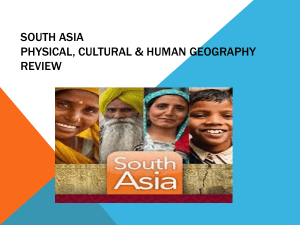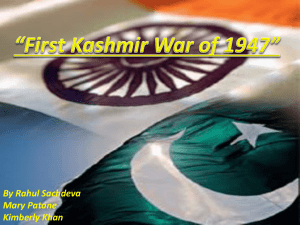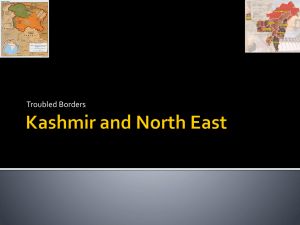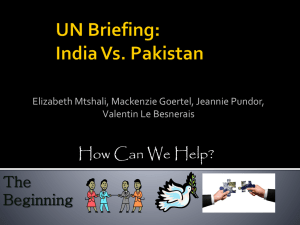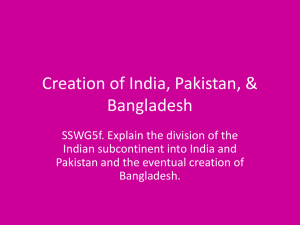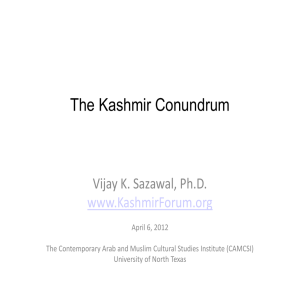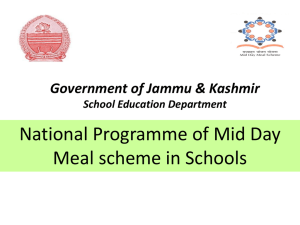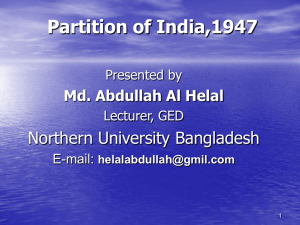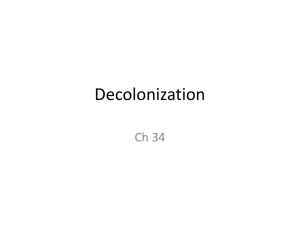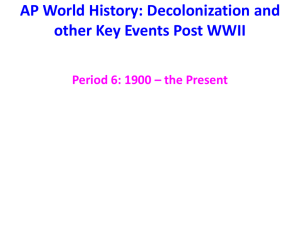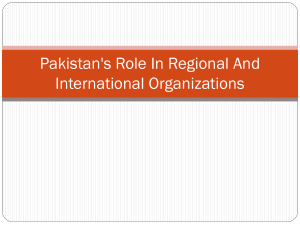Kashmir
advertisement
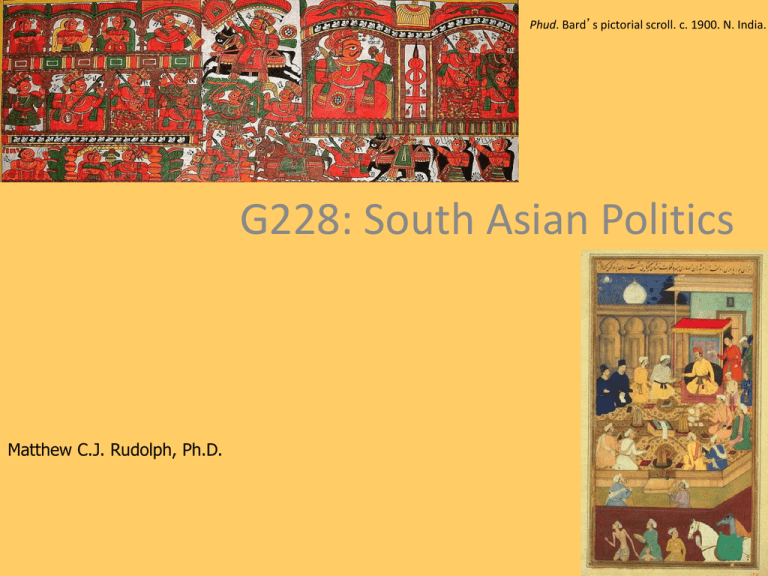
Phud. Bard’s pictorial scroll. c. 1900. N. India. G228: South Asian Politics Matthew C.J. Rudolph, Ph.D. Indo-US Relations and South Asia Cold War • US allied to Pakistan • India allied to the Soviet Union After the Cold War • US pulls out of Afghanistan and Pakistan • India lost strategically; approaches the US • US: “Stop, roll back, and eliminate nukes” 2 Kashmir: Still the Crux of the Rivalry? Siachen Glacier – 17,000 to 19,000 ft • Kashmir has been the crux of IndoPakistani rivalry since 1947 Wagah border post, evening closing ceremonies The Importance of Kashmir • • • The main point of contention between India and Pakistan. 3 wars: 1947, 1965, 1999 over Kashmir. (ongoing skirmishes) Insurgency since 1989 – death of 35,000-60,000 Kashmir Dispute • Kashmir dispute dates back to 1947 Partition of India – Pakistan claims Kashmir because of Muslim majority population – India claims Kashmir as part of multireligious, multi-ethnic nation • First India-Pakistan war fought over Kashmir (1947-48) • Ceasefire line established following war, UN monitoring • 1965 India-Pakistan war • After 1971 Bangladesh war, Line of Control re-established • Major insurgency after 1989 • 1999 Kargil war • 2003-04 Peace Talks • 2002 and 2008 state elections 5 6 Origin of the Conflict • 1941 – Muslim Nationalist movement reached its peak with the Urban professional/Elite Muslims demand for independence based on Muslim symbols. (Muslim League) • 1947 –British exit leaving behind two nations, India and Pakistan, and a disputed territory of Kashmir. The Design of the Partition • Muslim Majority Areas - 1909 • Elite Choice • Feasibility Kashmir: Time Line of Critical Events • 1946 election – Muslim League wins in Muslim Majority Area; Pakistan and India independence plans are announced; Kashmir announces a separate state. Riots in the country. • August 1947 – British departure – three countries. • October 1947 - Armed Muslim Tribes from Pakistan enter Kashmir. (Supported by the Pakistani military). • Mah. Hari Singh and Sheikh Abdullah ask Nehru for Military Assist. • Deal based on Accession, Autonomy, Plebiscite • Article 370: Employment, Land. • 1948 - Ceasefire lines established (UN). Kashmir: Time Line of Critical Events • 1963 – Askai Chin (China) • 1965 – India-Pakistan War (Nuclearizing India) • 1971 - Line of Control (Bhutto/I.Gandhi) • 1989 – Insurgency and Violence begins • 1999 – Kargil War (Nuclear Nations) Kashmir Divided Pakistani Kashmir • Azad Kashmir Same issues as rest of Pakistan. • Northern Kashmir Tribal and chiefs. Local Bazaar/Tribal Economy Low rates of literacy (12%) • Hub for anti-India jihadi groups. Earthquake made these groups visible Indian Kashmir – Religious Demography and Population Density • The Valley: Predominantly Muslim; 1990 exodus on Hindus; Srinagar • Jammu: Predominantly Hindus and Sikhs; Jammu • Ladhakh: 50% Buddhists, Muslims – 49 percent (Shia majority); Leh Kashmir: Control and Population Distribution Controlled Area Population Hindus Muslims Buddhists Others India Jammu 3 million 67% 30% - 3% The Valley 4 million 4% 95% - Ladakh .25 million - 49% 50% 1% N. Areas .9 - 99% - - Azad Kashmir .26 - 99% - - Aksai Chin ? - - - - Pakistan China Causes of Conflict I: External Intrusion • 1979-1988 - Pakistan launched a proxy war for US and Saudi Arabia during Afghan’s Soviet era (19781988) producing several jihadi groups targeting the “godless” Soviet Union and the Shias. • 1988 - Kashmir became the new front for Jihad and Hindus the new infidels. • India deployed more troops to Kashmir in the 1990’s to “fight fire with fire.” Associated Radical Jihadi Groups from Pakistan • Lashkar e-Toiba (LeT; 1980) • Hizbul Mujahideen (HUM) • Harkat-ul- Ansar (HUA) 1964;1988) • Jaish-e-Mohammad (JeM; 2000) • Jamaat Ul- Mujahideen (JuM) • Jammu and Kashmir Lib. Front (JKLF; Domestic Political Incentives for Conflict • 1947-1964: Nehru period – National Conference (NC) and the Congress have a deal which sometimes included Sheikh Abdullah. • During this period. India tries to constitutionally extend itself into Kashmir. • Sheikh Abdullah in and out of jail during this time. NC stays in powers. • 1966-1975 – Abdullah and Gandhi accord. National Conference in power marginalizing other groups. • Polarization of other religious groups as well other Muslim opposition within NC and without. (Language and religious symbols.) • 1975- Indira Gandhi Emergency • NC part of the opposition to the Emergency in No Insurgency 1979 Domestic Political Incentives for Conflict II • • • IG returns in 1980s – centralizes power. Attempts to oust Farooq Abdullah. Kashmiri Muslim backlash at undemocratic moves by opening doors to external insurgents. • • Rise of BJP in the 1980s. (Hindu backlash and Congress). J&K National Panther Party (Hindu/Kashmir – 1950). • Ladhakh Union Front Territory (led by LBA 1989) 2002. (Buddhist Backlash) Rising tensions due to conversions and desecration claims. Increasing attacks on each other by the youth starting in 1989 onwards. • • • 1999 election – 28% - Conference backed by the BJP govt. Alliance. (Hindu/Muslim Cooperation; excluding the separatist groups) • 2002 – Pakistan promises to withdraw support for Sunni radical groups • 2004 election – 46% - Peoples Democratic Party and Congress alliance. (Hindu/Muslim/Buddhist Cooperation) Other Points of Contention • Military presence, “occupation,” and civil military relations. – • • • 120,000 to 200,000 personnel. Military Economy Military-civil relations Development of the region. – – Water sharing with Pakistan Baglihar/Kashmir Dam Associated Separatist Groups • • All Party Hurriyat Conference umbrella organization Jammu and Kashmir Liberation Front 1964; 1988; 1996 Viability of Independent Kashmir • Pakistan’s historical perspective Inherent Part of Pakistan- incomplete partition China’s support (domestic reasons) • Indian’s historical perspective. Secularism offered them a place Indian Muslims (140 mil vs Kashmiri 8mil) - Setting precedence for ethnic groups - Kashmiriyat • Recent Resource Value Crossroads for rivers emerging from Himalaya After Mumbai “26-11”: Will India & Pakistan Fight Another War? • Conventional wars –1947-48 First Kashmir war –1962 Sino-Indian border war –1965 Rann of Kutch/Kashmir war –1971 E. Pakistan/Bangladesh war advent of mutual nuclear capabilities • Two serious crises –1986-87 Brasstacks crisis –1990 Kashmir crisis • • • • • 1999 limited war in Kargil Continued fighting in Kashmir 2002 military standoff 2003-04 Peace Talks 2008 Mumbai Attacks U.S. Policy Challenges • Balance of interests dilemma – U.S. interests are different, less intense and more sporadic than those of local actors. • Serves to limit U.S. influence • Regional security vs. counterterrorism – Solve Kashmir dispute or counter terrorists? • War prevention vs. nonproliferation – Prevent nuclear states from going to war, or prevent warprone states from going nuclear? – Efforts to solve regional problems might create undesirable precedents • e.g., technical assistance for C3 • Security assistance dilemma – U.S. efforts to increase one country’s security might increase other side’s insecurity. • e.g., missile defenses 21 S.P. Mukherjee, Iconic Antidote and Progenitor: Kashmir, Leadership Lineage and the BJP in Crisis S.P. Mukherjee, Iconic Antidote and Progenitor: Kashmir, Leadership Lineage and the BJP in Crisis Shyama Prasad Mukherjee 1901-1953 Tripolia Bazaar, Jaipur Where Mukherjee made the “Ek Nishan, Ek Pradhan, Ek Vidhan” speech 500 400 300 200 100 0 19 51 19 57 19 62 19 67 19 71 19 77 19 80 19 84 19 85 19 89 19 91 19 92 19 96 19 98 19 99 20 04 Parliamentary Seats BJP and its Predecessors' Electoral Performance: General Elections 1951-2004 Year Congress BJP and its Predecessors BJP HQ Delhi 2003: Mukherjee Portrait in Rear Dpty. PM Advani and BJP Gen. Sec. Naidu Ek Vidhan, Ek Nishan, Ek Pradhan One Constitution, One Flag, One Prime Minister Jammu and Kashmir Flag The Two PMs: Nehru and Sheikh Abdullah Jammu and Kashmir Deccan Herald Wednesday, June 24, 1953 S. P. Mookerjee Is Dead Dr. Syama Prasad Mookerjee, 52-year-old leader of the All India Bharatiya Jan Sangh and former Minister of the Central Government, passed away in the early hours of today at Srinagar. Dr. Mookerjee, who was under detention for entering the Kashmir State without permit, died of heart attack at 3.40 a.m. in the nursing home of the State Hospital. NEW DELHI, June 23 Questions
